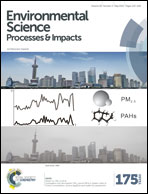Water quality assessment of a small peri-urban river using low and high frequency monitoring†
Abstract
The biogeochemical behaviors of small rivers that pass through suburban areas are difficult to understand because of the multi-origin inputs that can modify their behavior. In this context, a monitoring strategy has been designed for the Marque River, located in Lille Metropolitan area of northern France, that includes both low-frequency monitoring over a one-year period (monthly sampling) and high frequency monitoring (measurements every 10 minutes) in spring and summer. Several environmental and chemical parameters are evaluated including rainfall events, river flow, temperature, dissolved oxygen, turbidity, conductivity, nutritive salts and dissolved organic matter. Our results from the Marque River show that (i) it is impacted by both urban and agricultural inputs, and as a consequence, the concentrations of phosphate and inorganic nitrogen have degraded the water quality; (ii) the classic photosynthesis/respiration processes are disrupted by the inputs of organic matter and nutritive salts; (iii) during dry periods, the urban sewage inputs (treated or not) are more important during the day, as indicated by higher river flows and maximal concentrations of ammonium; (iv) phosphate concentrations depend on oxygen contents in the river; (v) high nutrient concentrations result in eutrophication of the Marque River with lower pH and oxygen concentrations in summer. During rainfalls, additional inputs of ammonium, biodegradable organic matter as well as sediment resuspension result in anoxic events; and finally (vi) concentrations of nitrate are approximately constant over the year, except in winter when higher inputs can be recorded. Having better identified the processes responsible for the observed water quality, a more informed remediation effort can be put forward to move this suburban river to a good status of water quality.


 Please wait while we load your content...
Please wait while we load your content...